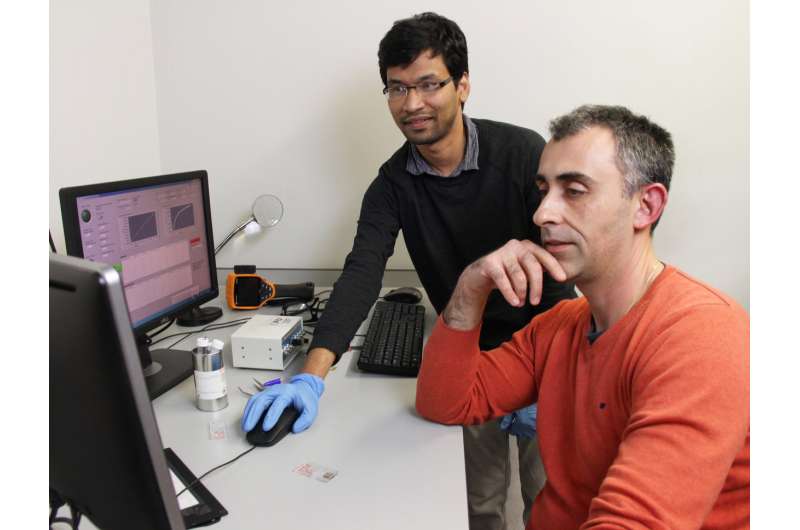Colloidal quantum dots make LEDs shine bright in the infrared

The ideal optoelectronic semiconductor material would be a strong light emitter and an efficient charge conductor to allow for electrical injection in devices. These two conditions, when met, can lead to highly efficient LEDs as well as to solar cells that approach the Shockley-Queisser limit. Until now, the materials that have come closest to meeting these conditions have been based on costly, epitaxially-grown III-V semiconductors that cannot be monolithically integrated to CMOS electronics.
The ICFO team now reports a processed nanocomposite system comprising infrared colloidal quantum dots. It meets these criteria, and at the same time, offers low cost and facile CMOS integration. Colloidal quantum dots (CQDs) are semiconductor particles or crystals as small as a few nanometers in size, which therefore have unique optical and electronic properties. They are excellent absorbers and emitters of light, and their properties change as a function of their size and shape: Smaller quantum dots emit in the blue range while larger quantum dots emit in the red.
The use of CQD LEDs could contribute to third-generation, solution-processed inorganic solar cells. The implementation of these nanocrystals in devices for optical sensing in the short-wave and mid-infrared have a vast number of applications, including surveillance, night vision, and environmental monitoring and spectroscopy.
In this recent study, published in Nature Nanotechnology, ICFO researchers Santanu Padhan, Francesco Di Stasio, Yu Bi, Shuchi Gupta, Sotirios Christodoulou, and Alexandros Stavrinadis, led by ICREA Prof. at ICFO Gerasimos Konstantatos, have developed CQD infrared-emitting LEDs with unprecedented values in the infrared range, an external quantum efficiency of 7.9 percent and a power conversion efficiency of 9.3 percent, a value never before attained with this type of device.
The key feature of this work has been the development of a CQD composite structure engineered at the suprananocrystalline level to reach unprecedentedly low electronic defect density. Prior efforts in suppressing electronic defects in CQD solids have been primarily been based on chemical passivation of the CQD surface, something that could not solve the problem in PbS QDs. The researchers at ICFO took an alternative path of creating the appropriate matrix in which they embedded the emitting QDs, to serve as a remote electronic passivant for the emitter CQDs. Moreover, the energetic landscape of the matrix was engineered in order to facilitate efficient charge funnelling into the QD emitters in order to achieve efficient electrical injection.
With these new hybrid devices, the researchers constructed solar cells to test their performance in the infrared range. They discovered that the effective passivation achieved in these nanocomposites, along with the modulation of the electronic density of states, results in solar cells that deliver open circuit voltage very close to the theoretical limit. The open circuit voltage (VOC), which is the maximum voltage available from a solar cell, increased from 0.4 V for a single QD configuration, up to ~0.7 V for the ternary blend configuration, an impressive value considering the lower bandgap of the cell at ~0.9 eV.
Researcher Gerasimos Konstantatos says, "The most surprising finding of this study is the extremely low electronic trap density that can be achieved in a conductive QD material system that is full of chemical defects arising on the surface of the dots. The very high quantum efficiency of those LEDs is the consequence of this passivation strategy. The other exciting outcome is the potential to reach such high VOC values for QD solar cells, thanks to the very low trap density, as well as to a novel engineering approach of the density of states in a semiconductor film."
Santanu Pradhan, the first author of the study, adds, "Next we will focus on how to further exploit this reduction of electronic density of states synergistically with other means to allow for simultaneous achievement of high Voc and current production, thereby targeting record power conversion efficiencies in solar cell devices."
The results obtained in this study prove that the engineering of QCD infrared-emitting LEDs at the nanoscale integrated in solar cells can significantly improve the performance efficiency of these devices in the infrared range. Such results open the pathway into a range of the spectra that is still to be fully exploited and offers amazing new applications, such as on-chip spectrometers for food inspection, environmental monitoring, manufacturing process monitoring as well as active imaging systems for biomedical or night vision applications.
More information: Santanu Pradhan et al, High-efficiency colloidal quantum dot infrared light-emitting diodes via engineering at the supra-nanocrystalline level, Nature Nanotechnology (2018). DOI: 10.1038/s41565-018-0312-y
Journal information: Nature Nanotechnology
Provided by ICFO




















